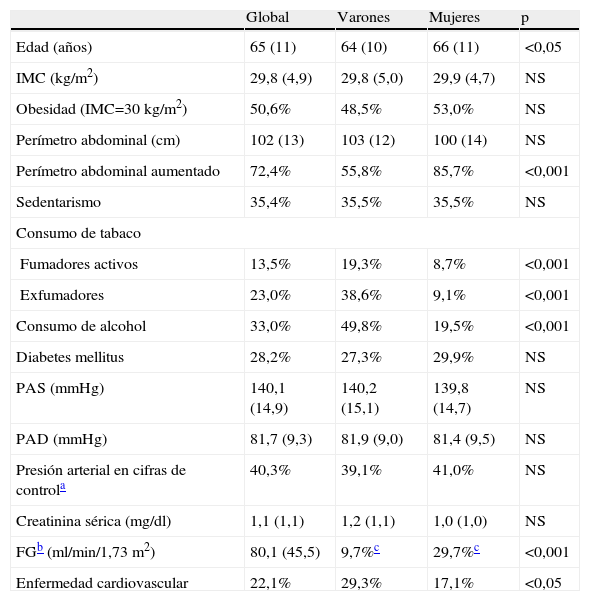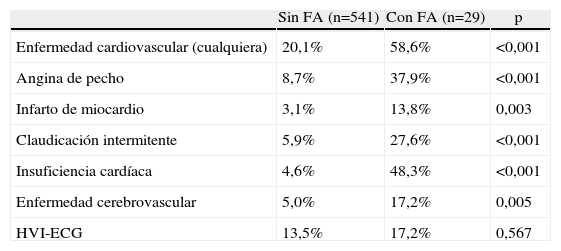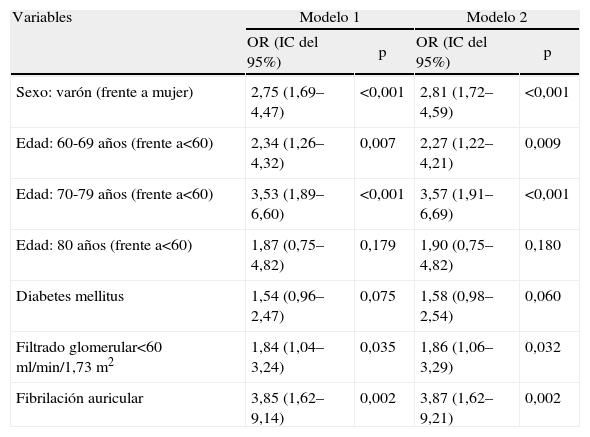el objetivo del estudio PREHVIA ha sido estimar la prevalencia de hipertrofia ventricular izquierda evidenciada en el electrocardiograma (HVI-ECG) y de fibrilación auricular (FA) en pacientes con hipertensión arterial (HTA) de Andalucía, y evaluar la relación de estas variables con la enfermedad cardiovascular (ECV).
Pacientes y métodosse realizó un estudio transversal con selección de centros de salud según la distribución de la población andaluza por provincias y hábitat, y selección aleatoria de pacientes incluidos en la muestra. Se recogieron los antecedentes y los médicos participantes y un cardiólogo experto valoraron la HVI-ECG aplicando los criterios de Cornell (voltaje y producto) y de Sokolow-Lyon. Se valoró la asociación con la HVI o la ECV mediante modelos de regresión logística.
Resultadosen 570 pacientes (edad media de 65 años, un 54,5% de mujeres, un 50,6% con obesidad y un 28,2% con diabetes), la prevalencia de HVI-ECG fue del 13,7% (intervalo de confianza [IC] del 95%, 10,8–16,6%). El 12,6% cumplió el criterio de Cornell y el 1,6% el de Sokolow-Lyon. Un 5,1% presentó FA (IC del 95%, 3,9–7,5%) y el 22,1% (IC del 95%, 18,4–25,4%) tenía antecedente de ECV. En el análisis multivariante, la HVI-ECG se relacionó con el sexo femenino (odds ratio=5,10; IC del 95%, 2,44–10,64) y la presencia de ECV (odds ratio=2,18; IC del 95%, 1,09–4,12). La ECV se relacionó independientemente con la edad avanzada, el sexo masculino y la FA, y con menos fuerza con un filtrado glomerular bajo y la diabetes mellitus.
Conclusionesen hipertensos de Andalucía la prevalencia de HVI-ECG es considerablemente inferior a la hallada en otros estudios, mucho mayor en mujeres y a expensas principalmente del criterio de Cornell. La prevalencia de FA es del 5,1% y la de ECV similar a la de estudios previos. Se observa una asociación independiente entre HVI-ECG y ECV, y entre ECV y FA.
The objective of the PREHVIA study was to assess the prevalence of electrocardiographic left ventricular hypertrophy (ECG-LVH) and of atrial fibrillation (AF) among Andalusian hypertensive patients, and the relationship of this complications with cardiovascular disease (CVD).
Patients and methodsCross-sectional study with selection of study centres following the distribution of the Andalusian population by provinces and habitat, and randomization of patients included in the sample. Personal history was recorded, and ECG-LVH was assessed using the Cornell (voltage and product) and Sokolow-Lyon criteria, applied by the participant physicians and by an expert cardiologist. The association with ECG-HVH or CVD was studied by logistic regression models.
ResultsIn 570 patients (mean age 65 years, 54.5% women, 50.6% with obesity, 28,2% with diabetes), the prevalence of ECG-LVH was 13.7% (95% confidence interval [CI], 10.8–16.6%). Cornell criterion was fulfilled by 12.6% and Sokolow-Lyon by 1.6%. The prevalence of AF was 5.1% (95% CI, 3.9–7.5%) and 22.1% (95% CI, 18.4–25.4%) had established CVD. In the multivariate analysis, ECG-LVH was associated with female gender (odds ratio=5.10; 95% CI, 2.44–10.64) and with the presence of CVD (odds ratio=2.18; 95% CI, 1.09–4.12). The antecedent of CVD was independently associated with an advanced age, male gender, AF and, less strongly, with low glomerular filtration rate and diabetes mellitus.
ConclusionsIn Andalusian hypertensives, the prevalence of ECG-LVH was significantly lower than that found in other studies, greater in women and at the expense of the Cornell criterion, the prevalence of AF was 5.1% and it was 22.1% for CVD with independent associations between ECG-LVH and between CVD and AF.















